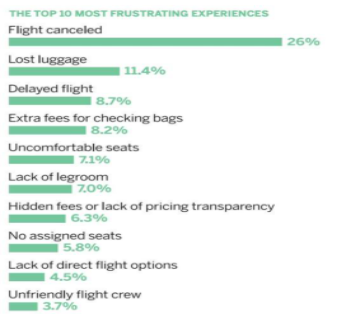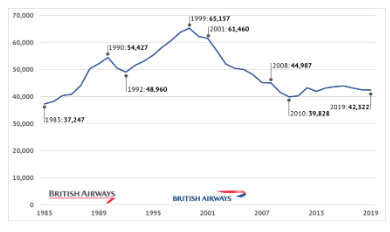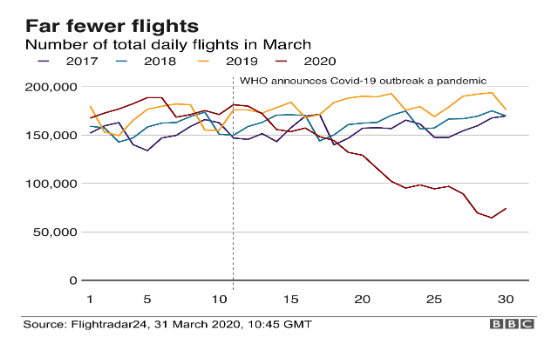Technology's Impact on British Airlines
1. Insight and Recommendation about the impact of technology on the organization or a selected function/process (300)
British airline is using technology to market the company and customer loyalty. Through technology, the company can reach new audiences and converting them into potential customers. Due to the internet, the company can communicate with many consumers through artificial intelligence (AI). Besides, the company is adopting chatbots to communicate with passengers and improve operations (Duggan et al., 2018). Through the technology, the company is able to create a long-term brand performance since it helps position and creates a preference for the brand while building awareness with influencers and purchasers.
Technology is helping the company to predict and forecast consumer behavior to tune their strategy effectively. The company uses Big Data, a huge volume of data that helps identify patterns in the chaos of this explosion in information to create smart solutions. Ayed et al. (2015) state that big data is coupled with artificial intelligence to help predict and forecast travelers' behavior. Besides, the technology is helping the company develop a robust plan, thus maintaining the company's competitive advantage.
Also, through biometrics technology, the company can identify and handle a huge number of passengers. Biometric technologies like fingerprints, facial recognition, and retinal scanning are being adopted for individual verification. This technology is making airport check-ins, migration formalities, and onboarding easy and faster. Besides, this technology is being extended to the baggage process and enabling passengers to keep real-time track of their luggage (Ayed et al., 2015).
Also, the company is working with Zamna, a company that uses facial recognition with blockchain technology. According to Huang et al. (2019), the company is using technology to improve its business process and improving workflows. The technology eliminates the need to rely on physical ID proofs to collect passengers’ data. Besides, it is critical in creating a robust security system for managing customer data.
Recommendation
I recommend that the company greatly invest in technology, including big data, artificial intelligence, and blockchain, to bring positive change and create a more attractive mode of travel in the future, which will make the company gain a competitive advantage.
2. Analyze current pain points of British Airways (300)
A pain point refers to challenges that prospective customers are experiencing. In British airlines, various issues and challenges make passengers frustrated to the extent of vowing never to fly with the airline again.
The first and most frequent challenge facing most people is flight cancellation. The company often cancels flights for many reasons, including labor shortage and workers strikes. Other causes include technical delays, which often delay the flight for more than 22 hours (Alibasic and Popovic, 2021). The study reveals that most people affected by the cancelation are those traveling for business, thus making them miss important responsibilities and events. Besides, flight delay is a significant challenge not only for British Airways but also across the world. This makes the company's credibility crumble and be placed on the 55th out of 65 in the airline reputation index (Alibasic and Popovic, 2021).
Another critical challenge among airline passengers is extra pay for checking bags. British Airways traveling is expensive, and most the ticket do not include all the additional costs that passengers are expected to pay. Silling (2019) states that the company price is ludicrous for European destinations. Besides, any cheap flight comes with hidden extra costs like paying up for a checked bag. Therefore the expenses to consumers are becoming a challenge to them.
Another common challenge that airline passengers experience includes uncomfortable seats. Most passengers complain of small and poorly designed seats, which make them uncomfortable. To make the matter worse, these are often not assigned, which means that the seat that individual book might not be their traveling sear which often discourages clients. Also, lack of direct flight options and unfriendly crew are primary challenges. However, unlike business individuals, some passengers have different perspectives on these challenges and often do not cite them as big frustrations (Silling, 2019).

3. Evaluate how pain points are triggered (internally/externally) (200)
One of the major internal triggers of the pain point is human resources. It is the most critical aspect of an organization and determines the failure or success of an organization. According to Taylor et al. (2019), British airlines face great challenges due to a shortage of workers or workers' strikes. The study reveals that staff often go to strike due to the company’s cost-cutting policies and general management issues. In most cases, pilots feel disrespected and consequently resign, thus leading to flight cancelation of shortage of pilots and other workers. This repetitive process leads to a cycle of perpetual dissatisfaction. Moreover, their customer care personnel cannot answer some questions, especially after a flight cancelation, thus harming market share.
From the external environment, technological factors are a great challenge to the company. Technology is a major component of the business and its operations. Taylor et al. (2019) state that technological failures create widespread problems in airlines, disrupting customer loyalty. British Airlines has been associated with many technical failures that have ruined millions of customers' plans (Cozmuta, 2021). Technology failure has resulted to uncountable hours of flight delay and cancelations thus creating mass confusion among customers. Besides, passengers’ financial and personal data is also hacked, thus greatly losing the company clients.
4. The potential risk of not solving them on time ( 100)
The company's cost reduction policies might make solving these problems a challenge. Among the company, cost-cutting measures include laying off employees, minimizing pay, and closing facilities. Besides, the company is eliminating outside professional services, thus discouraging most of its employees or quitting to look for better job security. For example, in 2020, due to the COVID-19 pandemic, the company reduced its employee salary by 20% and adopted an 8% average pay reduction policy in the long term (Blissett, 2021). At the same time, the company reduced more than 10,000 among cabin crew, airport staff, and engineers.

Another risk is rapid technological advancement. The advancement in technology is causing great risk since the company is prone to hacking and breaching customers’ data, thus increasing bad experiences among consumers. Similarly, advanced technology is more prone to failure if not well managed, leading to increased delay and flight cancelation.
5. How new Technology could resolve such pain points (200)
Through machine learning and artificial technology, flight delay and cancellation might be predicted, thus avoiding distraction and promoting client experience. Machine learning includes studying computer algorithms and improving and is part of artificial intelligence. These techniques are critical in predicting and managing human resources in the company and ensuring that there is improved operational efficiency. Besides, there is also another challenge of discomfort seats in the flight and poor entertainment challenges. Technology is thus critical in creating better connectivity and promoting passengers' travel experience. Likewise, technology is essential to reducing compensation fees due to flight delays and cancelation to increased efficiency.

Another great technology that can be applied in airlines is big data. This technology is critical, especially in describing and analyzing structured and unstructured data for the organization. The technology can analyze data for insights that lead to better decisions and strategic business moves. For example, the company can figure out traveling periods and predict several clients using its planes to travel globally using technology. Therefore, this technology is critical in deciding whether to add more technicians to prevent technological failures and improve maintenance to reduce flight delays.
Lastly, artificial intelligence is critical in assigning seats and designing comfortable seats, which are among the pain points among clients.
6. Critically evaluate the proposed new technology could lead to building a competitive advantage for the organization (200)
Technology is becoming the key principle in the air transport industry. Therefore, companies are being forced to be innovative to remain competitive in the industry. Among such technology is Artificial intelligence which is more than robots in the airline industry. This technology is being launched to revolutionize customer service and optimize efficiency. The technology is being used to deliver a personalized traveling experience to the passengers, creating optimum customer satisfaction (Wang & Song, 2020). The creation of customers’ satisfaction is critical to giving the company a competitive advantage.
Another challenge that clients experience is boring technology and discomfort. However, virtual reality & immersive experiences are becoming superior technology in solving these issues. Some of the companies promoting vertical reality among airlines include Evelop Airlines, SunExpress, and Jin Air. This technology enables airline clients to watch movies and other videos in a 360-degree view while still on the journey. The technology attracts many clients, thus increasing market share and becoming a critical competitive advantage in the airline industry.
Another technology winning in the airline business is In-flight connectivity. Traditionally, passengers were expected to switch off their phones in the plane. However, with the advancement of technology, companies like British airlines are adopting in-flight connectivity and eliminating the need to disconnect phones in the air. Besides, companies also offer free Wi-Fi services across airports and flights (Poulaki & Katsoni, 2020).
7. Potential barriers for implementing the new technology and recommendation to overcome the barriers (200)
One of the great challenges to the company's implementation of technology is the lack of capital. Over the years, the company has been experiencing slow growth of profits and sometimes loss. For instance, the company experienced a loss of €1.2bn in the first three months of 2021 and recorded a €7.4bn loss in 2020 due to the current COVID-19 pandemic (Hamawandy et al., 2021). This continuous loss to the company is a great barrier to implementing these technological advancements. Therefore, I recommend that the company implement a great marketing strategy regardless of the pandemic and ensure that any proposed spend is securely anchored in the overall vision for the business.

Another barrier is training and hiring professionals to manage these technologies- human resources. As mentioned, the company is implementing cost-cutting policies, which include reducing employees. Therefore, due to job insecurity and low pay, it might not get the most talented candidates to manage its technologies. Consequently, they might be forced to training existing employees to deal with the technology, thus limiting its application. However, I recommend that the company implement a training program that caters to technology development and invest in the technology while improving employee salaries.
Another barrier is disruption concerns. Most people are reluctant to change. Therefore the implementation of new technology might be faced with resistance. However, I recommend that the company increase employee awareness of the technology and use Kotter's change management theory to implement the changes (Laig & Abocejo, 2021).
References
Alibasic, A. and Popovic, T., 2021, February. Applying natural language processing to analyze customer satisfaction. In 2021 25th International Conference on Information Technology (IT) (pp. 1-4). IEEE.
Ayed, A.B., Halima, M.B. and Alimi, A.M., 2015, May. Big data analytics for logistics and transportation. In 2015 4th international conference on advanced logistics and transport (ICALT) (pp. 311-316). IEEE.
Blissett, E., 2021. Phil Taylor and Sian Moore (with Robert Byford), Cabin Crew Conflict: The British Airways Dispute 2009–11.
Cozmuta, A., 2021. Selling ‘The World’s Favourite Airline’: British Airways’ privatisation and the motives behind it. Business History, pp.1-20.
Duggan, L.V., Lockhart, S.L., Cook, T.M., O'Sullivan, E.P., Dare, T. and Baker, P.A., 2018. The Airway App: exploring the role of smartphone technology to capture emergency front‐of‐neck airway experiences internationally. Anaesthesia, 73(6), pp.703-710.
Hamawandy, N.M., Ali, R., Bewani, H.A.W.A., Rahman, S.K. and Othman, B.J., 2021. The financial Impacts of (COVID-19) on financial reporting quality Airlines Companies: British Airlines. Journal of Contemporary Issues in Business and Government, 27(2), pp.5264-5271.
Huang, X., Zhang, J.A., Liu, R.P., Guo, Y.J. and Hanzo, L., 2019. Airplane-aided integrated networking for 6G wireless: Will it work?. IEEE Vehicular Technology Magazine, 14(3), pp.84-91.
Laig, R.B.D. and Abocejo, F.T., 2021. Change Management Process in a Mining Company: Kotter’s 8-Step Change Model. Organization, 5(3), pp.31-50.
Poulaki, I., & Katsoni, V. (2020). Current trends in air services distribution channel strategy: evolution through digital transformation. In Cultural and Tourism Innovation in the Digital Era (pp. 257-267). Springer, Cham.
Silling, U., 2019. Aviation of the future: What needs to change to get aviation fit for the twenty-first century. In Aviation and Its Management-Global Challenges and Opportunities. IntechOpen.
Taylor, P., Moore, S. and Byford, R., 2019. Cabin Crew Conflict-The British Airways Dispute 2009-11.
Wang, Z. and Song, W.K., 2020. Sustainable airport development with performance evaluation forecasts: A case study of 12 Asian airports. Journal of Air Transport Management, 89, p.101925.
Take a deeper dive into Technology, Innovation, and Corporate Social Responsibility with our additional resources.
- 24/7 Customer Support
- 100% Customer Satisfaction
- No Privacy Violation
- Quick Services
- Subject Experts



